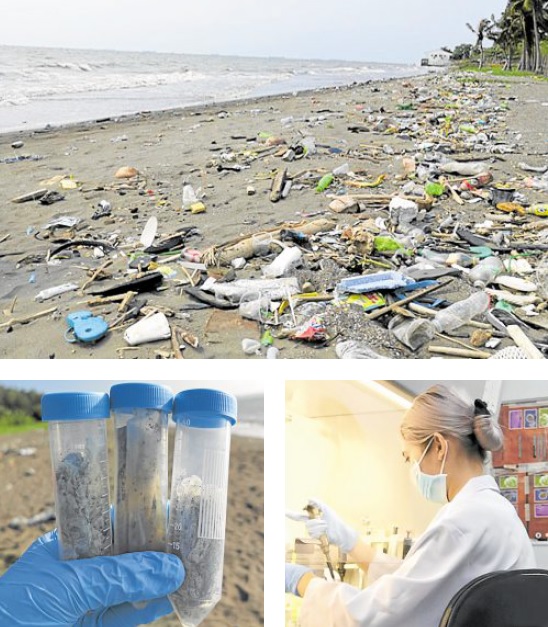UP scientists race to find plastic-eating microbes

‘MICROBIAL COMMUNITIES’ | A team of researchers from the University of the Philippines Marine Science Institute collects sediment samples at the heavily polluted Manila Bay (top photo) to study how microbes and other bacterial species could be harnessed to break down plastic waste. (Photos from the UP Marine Science Institute)
BOLINAO, Pangasinan, Philippines — Inside the country’s first and only plastics research laboratory, a team of scientists from the University of the Philippines Marine Science Institute (UPMSI) is looking at an unlikely ally — microbial organisms — that could literally take a bite out of the mammoth problem of plastic pollution.
The team led by oceanographer Dr. Deo Florence Onda said it had identified bacteria that could break down that kind of garbage.
“It’s just a matter of trying to explore and search for that ‘superbug’ that can actually degrade the plastics,” Onda told the Inquirer. “It’s just a very long process.”
Breakthroughs in this pursuit could open up new ways to tackle the ecological crisis of plastic waste piling up on the planet and littering the oceans.
In the Philippines, serious research into that phenomenon, besides being relatively new, is further hampered by lack of funding.
This has limited such efforts to mostly monitoring how much of that trash gets thrown into the environment, rather than how it affects particular ecosystems.
The country has earned the unflattering distinction of being the third biggest plastics polluter worldwide after China and Indonesia, according to a 2021 World Bank report which affirmed an earlier study done in 2015.
Gaps, opportunities
In 2020, Onda’s team published a study titled “Marine Microbes and Plastic Debris: Research Status and Opportunities in the Philippines.”
It identified gaps as well as opportunities in local plastics research — such as exploring how microbes interact with these materials which otherwise would take some 1,000 years to decompose.
Microbes are the “first and last organisms to interact with plastics,” said Justine Bitalac, a senior research specialist and former graduate student of Onda.
She noted that these hardy survivors cling to and feed on plastic waste as they drift into the ocean.
In the study, the team members took note of earlier research done abroad which already showed that some bacterial species could be “good models for metabolizing plastic.” Such species include the bacterium Ideonella sakaiensis, which — as Japanese scientists discovered in 2016 — was able to degrade polyethylene terephthalate, the synthetic commonly used for manufacturing beverage bottles and other liquid containers.
The study urged local researchers to explore how microbial biodegrading “could be further harnessed.”
But this is no mean feat, as biodegradation itself “is very difficult to measure [and] takes a long time,” said Norchel Gomez, another senior research specialist on the team like Bitalac.
‘Pits and holes’
Nevertheless, the two researchers set off to examine microbial biodegrading in heavily polluted Manila Bay.
There, Gomez found “members of microbial communities” from the bay’s sediments, collected those samples and incubated them for about three months.
She identified 18 bacterial entities, or “taxa,” most of which were cited in previous studies as being able to break down hydrocarbons—the same compound found in gas, coal, and crude oil.
“[This] makes sense because plastics share the same structure with them,” Gomez said.
The next step was “to isolate the specific species [that] are actual biodegraders of plastics,” said Bitalac, who took off from Gomez’s discovery.
She isolated 10 different species, the majority of which were from the Halomonas genus.
Bitalac said these bacteria punctured the plastic, creating “pits and holes” within 60 days.
It was as if they were eating it, she said.
‘Problematic byproduct’
Gomez’s findings were accepted for publication on Dec. 2 by the Archives of Microbiology Journal in Berlin, while Bitalac’s research is undergoing revision for publication in the Netherlands-based Journal for Hazardous Materials. But the team members are still careful about “overselling” their initial results, especially since plastic biodegradation releases carbon dioxide.
Onda said: “Even if we do get to a point that we’re able to completely degrade [plastic], most of it would be converted to greenhouse gases—and how much of that byproduct would be problematic to the climate?”
While it’s good to know that there are plastic-eating bacteria out there, efforts to curb pollution “should be at each stage of the life cycle of the plastic—from production to consumption and recycling,” he said.
Still, understanding how microbes work could lead to other remedies.
Manufacturers, for one, could start redesigning their products to make them easier for biodegrading. And scientists may craft more accurate climate solutions based on how much greenhouse gases are released by decomposing materials.
“Even if we don’t reach our end goal of finding that ‘superbug,’ we might be able to learn more about something else,” Onda said.
“That’s the beauty of it—the more you know, the more you understand.”
* * *
This story was written as a final output of the Blue Beat Initiative, a short course on marine science communication by the University of the Philippines Marine Science Institute and the Association of Young Environmental Journalists under the National Security Council-funded project, “Upgrading Capacity, Infrastructure and Assets for Marine Scientific Research in the Philippines.”